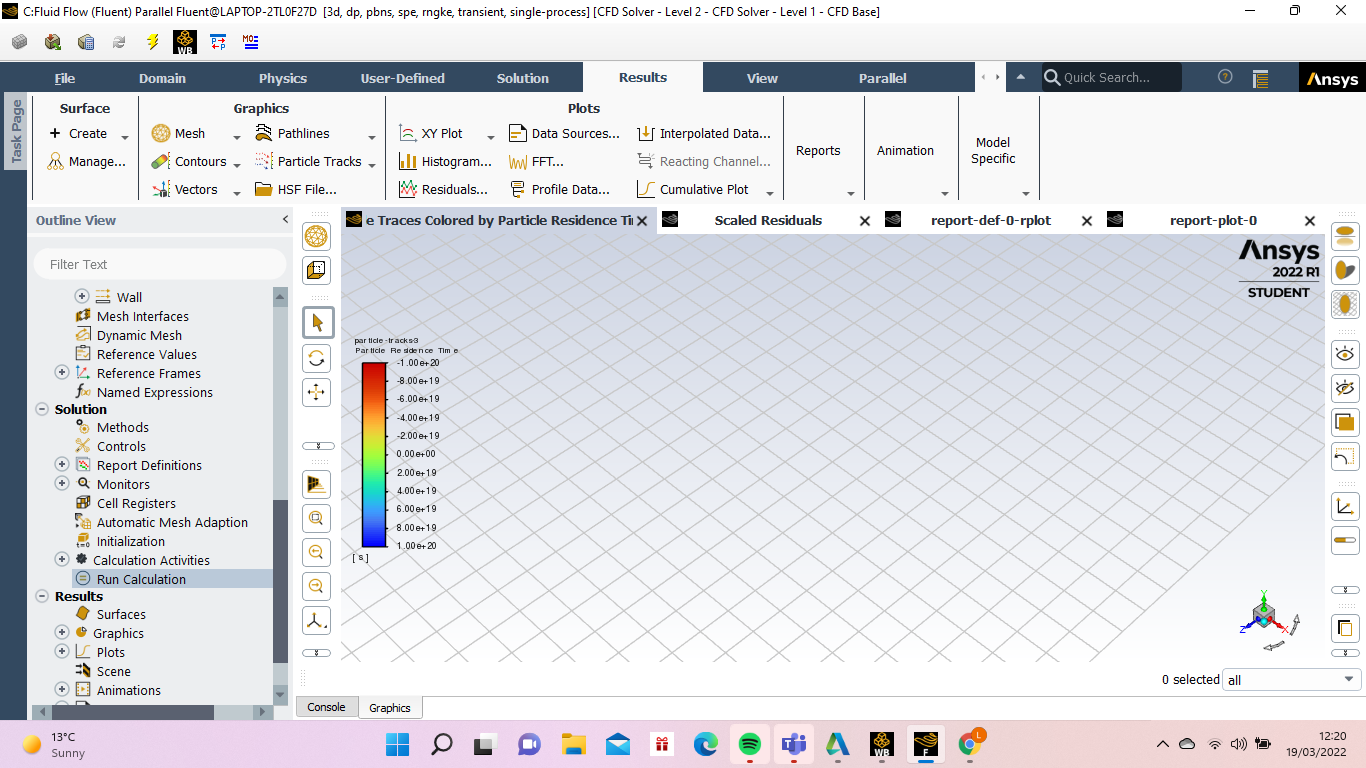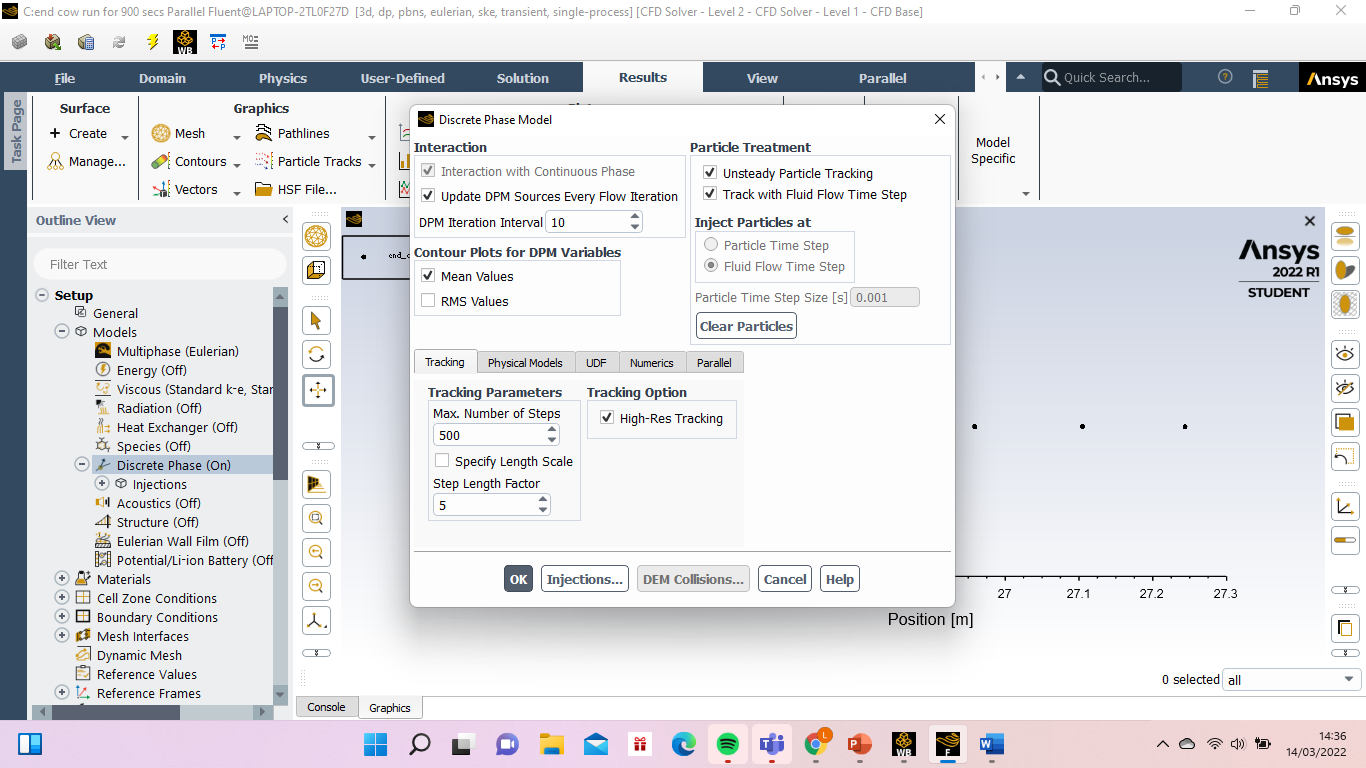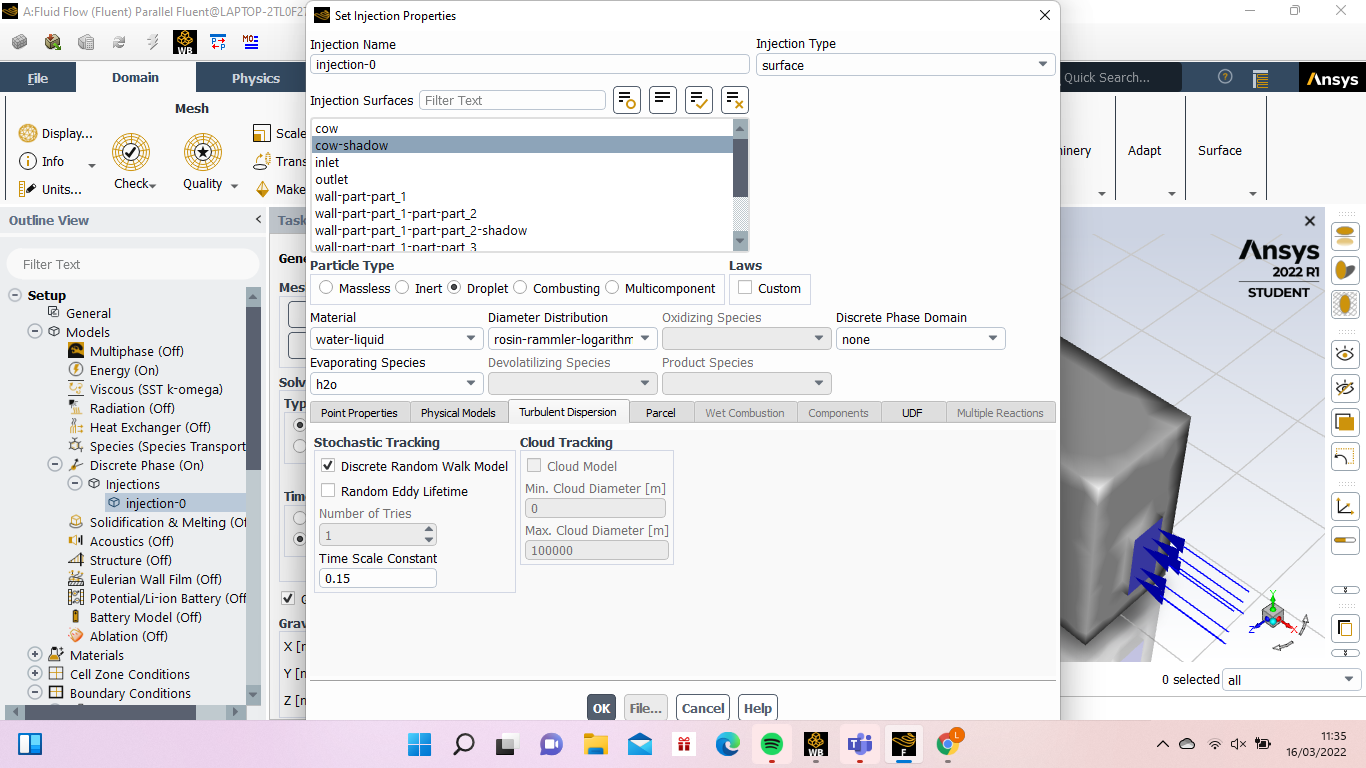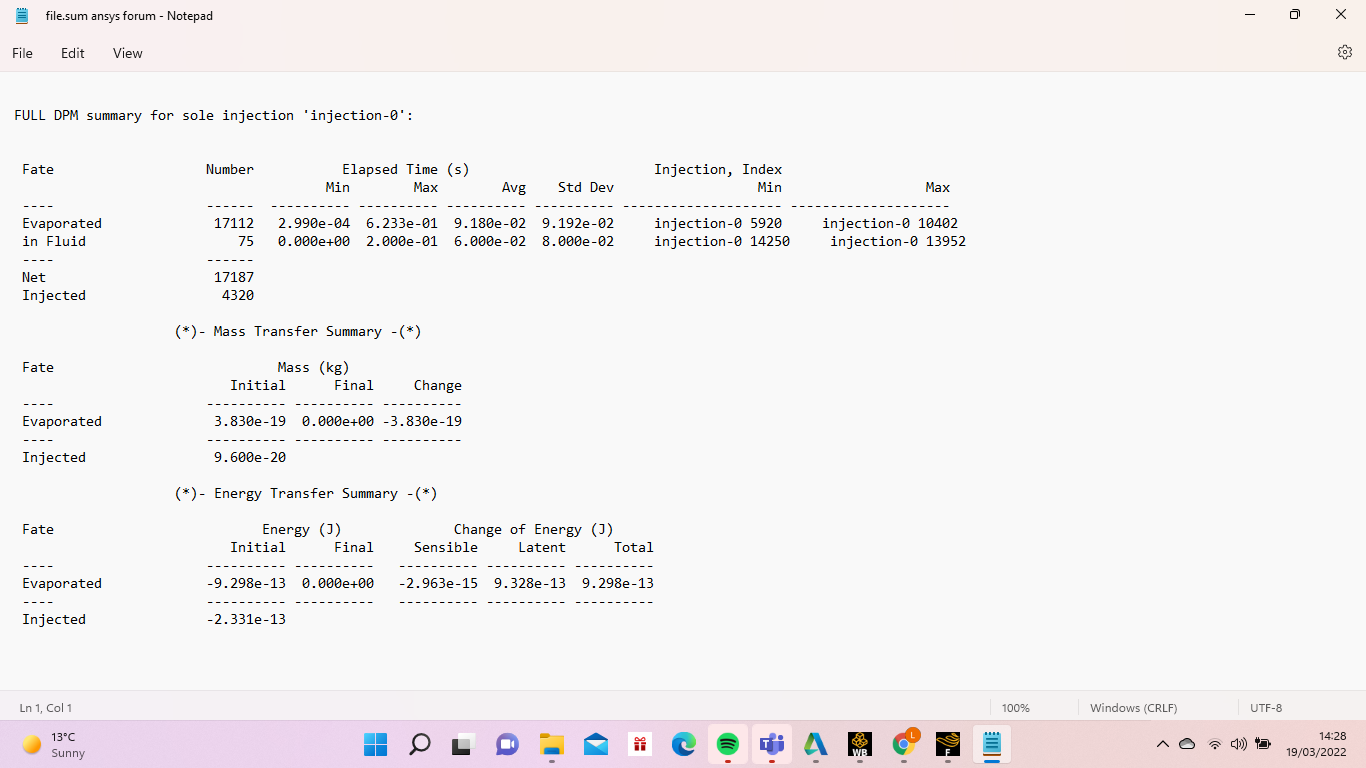TAGGED: ansys-fluent, ansys-student, ansys-workbench, fluent, fluid-flow
-
-
March 14, 2022 at 2:40 pm
Lylad
SubscriberHi, I am creating a particle flow using DPM I want to figure out the total flow rate of my particles I found on the other forums that the formula is m_dot=# particles per sec [#/s] * mass of particle [kg].
But I just wanted to ask what this part meant # particles per sec [#/s], I understand it's the "strength" and is the reciprocal of the particle time step but how should I determine the particle time step as I understand that the default is 0.001 ?
Also does the particle time step mean the rate of particles being released ?
March 14, 2022 at 4:05 pmRob
Forum ModeratorThe flow rate is either taken from the reports or read from the injection panel (out and in respectively). Given we work with parcels that may or may not be of equal mass you need to be little careful.
Particle time step is something you set, in the above it's the same as the flow time step. If you're running a steady flow you can use transient particles so there's a particle time step to consider.
March 14, 2022 at 5:00 pmLylad
SubscriberHi rob thank you so much for your reply, if I wanted to calculate the flow rate would I use the formula above ?
And does that mean that the particle time step is equal to the flow time step that you specify in the run calculation page?
Just as context I am running a simulation with a cow coughing and releasing particles therefore I would like to set a rate for the release of particles therefore I would like to set the total flow rate (the rate of the cow releasing particles).
March 15, 2022 at 9:31 amRob
Forum ModeratorFlow rate (entering) is what ever you need it to be: you work out how much mass is entering. For a cow coughing that will be a very small kg/s value. The issue is whether you want to model the cough, and therefore a transient case or steady in which case you want to review the boundary conditions.
March 15, 2022 at 10:32 amLylad
SubscriberHi rob I figured out the mass of the particles being 3.6e-14 kg then do I divide it by the time I want the cow coughing for ?
And I am using a transient case to model the transient airflow into the barn in my study, does that seem correct ?
Thanks sorry for all the question :)
March 15, 2022 at 2:15 pmRob
Forum ModeratorYes, so if the cow coughs for 0.5s you need 7.2e-14 kg/s However, have a think about the size of the domain compared to the flow of gas from the cow. How long do you think it'll take for the particles to leave the system, and how much of an effect do you think the cough will have?
March 15, 2022 at 7:25 pmLylad
SubscriberHi Rob, okay thats fine I will calculate that I am going to have the cow coughing then respiring out for 10 secs overall so I will have the flow rate as 3.6e-15. So this should be long enough to make an effect on the system.
Also, I have tried to look at modelling droplets for my particles to allow evaporation but once I have run the simulation it says that 0 number of particles have been tracked therefore I am slightly confused why this might be, if not I assume I can just use inert particles to model infectious aerosol ?
Thank you :)
March 16, 2022 at 11:23 amRob
Forum ModeratorProbably safer, and not modelling species will speed up the calculation. Check you are actually adding particles into the system too.
March 16, 2022 at 11:36 amMarch 16, 2022 at 11:52 amRob
Forum ModeratorIs the model transient?
March 16, 2022 at 11:53 amLylad
SubscriberYes it is
March 16, 2022 at 1:57 pmRob
Forum ModeratorThe number of tries is to kick trajectories off the mean path when running steady. In a transient run the assumption is that a particle release happens every time step so the changing flow will do that. Turning on Random Walk means the trajectory gets the random kick, but you don't get extra parcels.
March 18, 2022 at 4:56 pmLylad
SubscriberHi thank you rob for your answer.
Also I have another question i've been using the droplet function for the particle type however it only seems to show the particle results when the simulation is in steady state.
But I want to run the simulation in transient is there something else I need to enable or another reason for this ?
Thanks :)
March 18, 2022 at 8:13 pmAmine Ben Hadj Ali
Ansys EmployeeAdjust stop and start times for the injection as first thing to check.
March 19, 2022 at 11:12 amLylad
SubscriberHi thanks for replying my start time is 0 secs and the stop time is 10 secs, should I try to change this to see what happens ?
March 19, 2022 at 12:23 pmLylad
SubscriberHi just to confirm these are the boundaries I am using but its not showing any particle tracks in results
Transient: on, gravity y=-9.81
Models- Energy= on, Species transport= on, viscous= k-epsilon/ RNG/Standard Wall functions
Discrete Phase= ON, interaction with continuous phase , unsteady particle tracking, track with fluid flow time step.
Injection= surface, particle type= droplet, material= water liquid, evaporating species= H20, diameter distribution= rosin- rammler.
injection velocity= 10 m/s, temp= 300 K, start time =0 stop time= 10 secs, flow rate= 1e-20, mean diameter= 1e-5, ticked scale flow rate by face area
Then for boundary conditions= inlet= 8.7 m/s and outlet= gauge pressure is 0 (nothing changed for the outlet values)
Hybrid initialization
Run calculation; number of time steps= 1000, time step size= 0.1, max iterations= 20
Bellow I have put a picture of what results it produces when I try to run droplet particles I'm not sure why it's not showing proper particle tracks I would appreciate any help as I want to model droplet infectious aerosol with a transient model.

March 19, 2022 at 1:29 pmAmine Ben Hadj Ali
Ansys EmployeeIf you display the particle summary what do you see in the console?
March 19, 2022 at 2:29 pmMarch 19, 2022 at 3:55 pmAmine Ben Hadj Ali
Ansys EmployeeAlmost all particles have evaporated. So no particles traces can be displayed as they are not there. The other remaining particles are still in domain and you should be able to see them. You scale up the size of displayed particles.
March 19, 2022 at 8:09 pmLylad
SubscriberThank you so much DrAmie I've increased the size of the particles and I think thats worked :)
March 20, 2022 at 6:11 pmAmine Ben Hadj Ali
Ansys EmployeeWelcome ƒÖÅ
Viewing 20 reply threads- The topic ‘Total flow rate of particles formula’ is closed to new replies.
Innovation SpaceTrending discussions- air flow in and out of computer case
- Varying Bond model parameters to mimic soil particle cohesion/stiction
- Eroded Mass due to Erosion of Soil Particles by Fluids
- I am doing a corona simulation. But particles are not spreading.
- Centrifugal Fan Analysis for Determination of Characteristic Curve
- Guidance needed for Conjugate Heat Transfer Analysis for a 3s3p Li-ion Battery
- Issue to compile a UDF in ANSYS Fluent
- JACOBI Convergence Issue in ANSYS AQWA
- affinity not set
- Resuming SAG Mill Simulation with New Particle Batch in Rocky
Top Contributors-
4167
-
1487
-
1363
-
1194
-
1021
Top Rated Tags© 2025 Copyright ANSYS, Inc. All rights reserved.
Ansys does not support the usage of unauthorized Ansys software. Please visit www.ansys.com to obtain an official distribution.
-
The Ansys Learning Forum is a public forum. You are prohibited from providing (i) information that is confidential to You, your employer, or any third party, (ii) Personal Data or individually identifiable health information, (iii) any information that is U.S. Government Classified, Controlled Unclassified Information, International Traffic in Arms Regulators (ITAR) or Export Administration Regulators (EAR) controlled or otherwise have been determined by the United States Government or by a foreign government to require protection against unauthorized disclosure for reasons of national security, or (iv) topics or information restricted by the People's Republic of China data protection and privacy laws.














